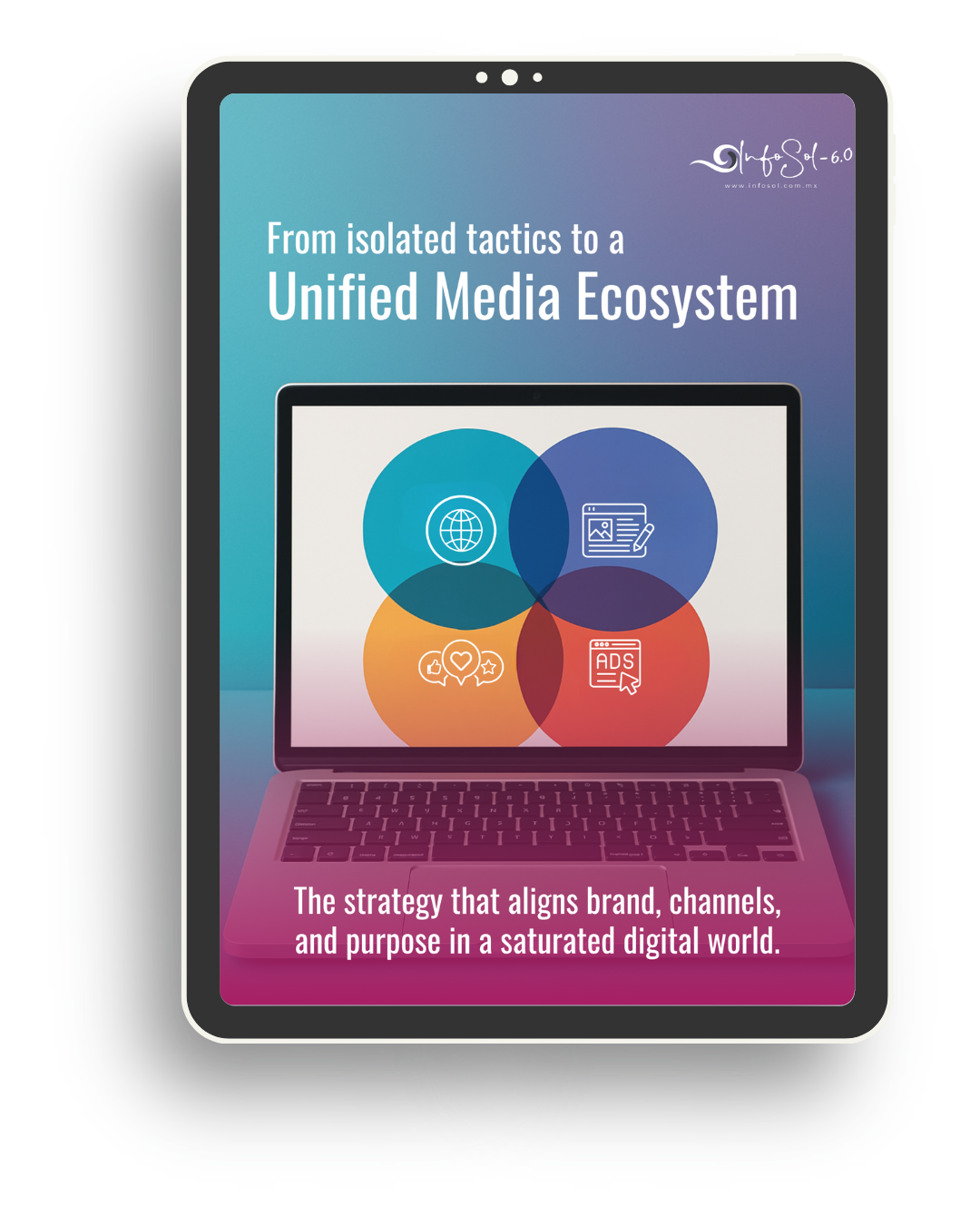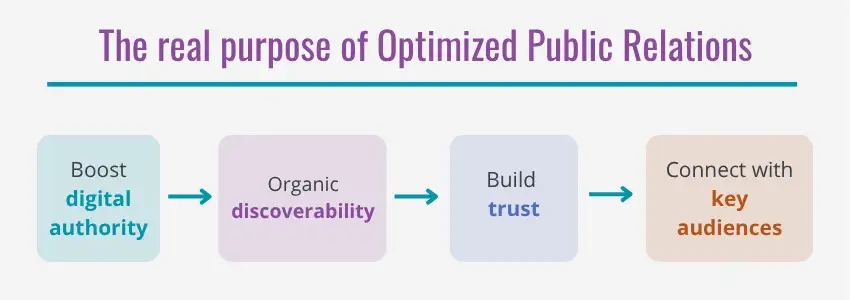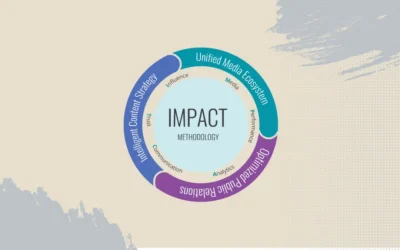In today’s business landscape —where artificial intelligence is redefining how audiences discover, compare, and trust brands— the benefits of public relations for a company have become a decisive factor for growth. Communicating is no longer enough: brands that truly stand out are those that connect, inspire, create tangible value, and get discovered at key decision-making moments.
To reach that level of visibility and influence, organizations need a comprehensive strategy that combines digital authority, organic discovery, a strong reputation, and emotional connection with their audiences. This approach is what we call Optimized Public Relations (OPR): a strategic synergy between
- Traditional PR, “a strategic communication process that builds mutually beneficial relationships between organizations and their publics,” according to the Public Relations Society of America (PRSA);
- Digital marketing, or “the use of multiple digital tactics and channels to connect with consumers online, right where they spend most of their time,” as defined by the American Marketing Association (AMA); and
- SEO, which Semrush defines as “the set of processes aimed at improving your website’s visibility in search engines (such as Google) with the goal of driving more organic traffic.”
OPR is implemented through a Unified Media Ecosystem — earned, shared, owned, and, when necessary, paid media — that amplifies key messages, positions the brand in both traditional search and AI-generated conversations, and strengthens its credibility among decision-makers.
If you’re considering how to launch or evolve your PR efforts, this guide is your starting point. Here you’ll discover eight public relations advantages that create real value in B2B contexts, backed by proven practices designed to influence from the first search to the final decision.
The benefits of public relations for a company
Public relations are often associated solely with visibility or media coverage, but their impact goes far beyond that. Below are the key benefits that show how this discipline drives trust, reputation, and strategic growth.
1. They increase visibility for your products or services
Public relations amplify your brand’s visibility by positioning it through trusted external voices such as business, finance, or industry media, opinion leaders, and analysts. This third-party exposure creates more impact than direct advertising by sparking interest, reinforcing authority, and improving recall.
When integrated with digital marketing—through search-optimized content or online media coverage—PR ensures your brand appears before the right audiences at the most critical points in the buying cycle. This drives strategic recognition, especially relevant in B2B environments where decisions increasingly depend on what is found through search engines, including AI-powered ones.
2. They help your brand get discovered when it matters most
Public relations boost organic discovery—the way users naturally find a brand or topic without paid advertising—by positioning your brand within the content audiences already consume: interviews, mentions, thought leadership articles, or collaborations with specialized media.
This visibility, aligned with search intent, allows your brand to appear in relevant contexts without relying solely on paid ads. Combined with SEO tools, well-structured content architecture, and optimized content marketing, PR reinforces your digital presence precisely when prospects need you most. It’s no surprise that more executives and CEOs are turning to public relations services.

…of communication and public relations leaders state that senior management seeks their counsel more often than in previous years.
3. They improve your position in search results
Backlinks from trusted media remain one of the most influential factors in improving SEO. Digital PR naturally generates these links by earning coverage in relevant outlets, increasing domain authority and boosting visibility for key searches within your B2B industry.
Linked to an evergreen content strategy, each article or feature can have a lasting impact, keeping your brand visible in relevant organic searches over time.
4. They build lasting relationships with potential clients
The advantages of public relations go beyond generating coverage—they build real connections. In a market oversaturated with commercial messages, what sets a brand apart is its ability to establish an authentic, emotional bond with its audiences. PR helps create relationships that go beyond transactions, strengthening loyalty, engagement, and advocacy.
Through valuable content, participation in relevant topics, and presence in trusted media, PR builds a coherent and relatable brand narrative that captures attention—and preference. This is especially important in long or multi-influencers, where credibility is earned through consistency and meaningful presence.
5. They manage your online reputation
In the digital environment, reputation can be affected in real time. A well-designed public relations strategy not only builds a positive image but also enables anticipation, management, and agile response to critical situations. In markets where trust is key, having a solid narrative and a preventive approach makes all the difference.
OPR enables monitoring of conversations, articulation of key messages, coordination of spokespersons, and response to potential crises. Social listening is essential—it helps detect comments, trends, or early signs of negative perception that could escalate if not addressed promptly. This not only protects your reputation but also strengthens your brand’s position as a reliable, transparent, and well-prepared organization.
6. They drive demand through earned media
In complex purchasing processes—where trust and third-party validation are decisive—earned media (editorial exposure obtained by merit, not payment) play a key role. They serve as credible endorsements of your value proposition. When a specialized outlet, analyst, or opinion leader mentions your brand positively, that exposure builds authority and influences consideration of your solutions.
An effective OPR strategy enhances this effect through interviews, articles, bylines, and editorial collaborations that directly impact demand generation. These mentions not only position your company but also reinforce its legitimacy among those evaluating providers and making key decisions.
DOWNLOAD OUR FREE EBOOK
Turn your communication into tangible results.

7. They boost internal morale and cohesion
Although PR impact is often associated with external visibility, its internal effect is equally valuable. Positive, consistent media presence fosters pride, motivation, and a sense of belonging among employees—maximizing the benefits of public relations.
When teams see their company recognized for leadership, values, or industry contribution, organizational culture strengthens. This externally validated recognition drives engagement and improves talent retention, especially in organizations where work is not directly exposed to end consumers.
8. They turn your customers into brand advocates
In markets where peer recommendations directly influence opportunity generation, PR amplifies success stories, testimonials, and real experiences. These efforts encourage customers to act as promoters, sharing their voices and experiences in favor of your brand.
An OPR strategy makes it easier for these voices to be featured in relevant media, editorial content, social platforms, or industry events—creating authentic credibility. This reaffirms the advantages of public relations in B2B environments.
Such external validation not only adds reputational value but also directly influences those seeking solutions supported by clear, verifiable references. As American industrialist Henry Ford once said:
Stopping advertising and public relations to save money is like stopping your clock to save time.
Henry Ford
Examples of public relations in action
Now that you know the benefits, let’s look at how they materialize through concrete strategies that deliver tangible results—from strengthening reputation to amplifying digital visibility or advancing social causes. Below are examples of public relations from organizations in sectors such as technology, transportation, printing, and healthcare, which have successfully engaged their audiences through optimized PR strategies.
Backlink strategy and organic positioning
A technology company specializing in identity verification implemented a strategy combining PR and SEO to position itself as a benchmark in regulatory compliance. Through interviews with specialized media, optimized content, and link-building, it achieved over 150 publications and sustained growth in referral traffic, consolidating its reputation in a highly competitive market.
Strategic alliances and regional reputation building
A leading cold-chain logistics company strengthened its visibility in Latin America through narratives centered on innovation and sustainability. The strategy integrated specialized media, buzz marketing, and social networks, reaching over 36,000 interactions and establishing a strong regional presence that reinforced its leadership in smart logistics and mobility.
Visibility at trade shows and industrial link-building
A large-format printing company expanded its presence at specialized trade fairs through digital PR and B2B influencer engagement. The campaign included media coverage, backlink strategies, and participation in key industry events, reaching over 650,000 people and solidifying its position as a leader in industrial design and personalization.
Thought leadership on social media
A global technology infrastructure company elevated its regional vice president’s profile as a thought leader through a LinkedIn and X (formerly Twitter) strategy. With specialized content and multichannel amplification, it increased its social selling index by 25 points, reached over 980,000 followers, and reinforced its digital authority across multiple sectors.
How to demonstrate the value of public relations
One of the most common challenges in complex decision-making environments is justifying investment in strategic communication. However, when implemented under the Optimized Public Relations (OPR) model, actions can be measured through clear indicators aligned with marketing and business objectives.
To evaluate real impact, it’s essential to combine traditional PR metrics with digital indicators that reflect visibility, influence, and results. Depending on the goal—whether increasing visibility, generating demand, positioning leadership, or strengthening reputation—metrics may include:
- Brand Visibility and Authority
-
- Coverage in relevant (Tier 1 and niche) media
- Share of Voice compared to competitors
- Backlinks from high-authority websites
- Digital Engagement and Participation
-
- Website traffic generated by earned media
- Social interactions and mentions
- Participation in strategic conversations
- Business and Reputation Outcomes
-
- Conversions attributable to PR actions
- SEO ranking for target keywords
- Brand recognition and preference among key audiences
These metrics should be tailored to each RPO strategy. Beyond the numbers, the true value of public relations lies in building trust, generating preference, and opening sustainable business opportunities. These are some of the most significant advantages that make PR a strategic asset for any organization.
Current Trends in Public Relations
Trends in public relations define the difference between a brand that merely informs and one that connects, inspires, and builds trust. The combination of new technologies, more demanding audiences, and the need to demonstrate tangible impact compels PR professionals to reinvent their strategies. Understanding these trends is key to strengthening reputation and digital positioning in an increasingly competitive market.
Why Public Relations Matter
Optimized Public Relations (RPO) are not just another tactic—they represent the evolution of communication in an era where credibility and visibility determine business success.
Organizations that integrate a Unified Media Ecosystem —earned, owned, shared, and paid media— are able to make an impact at the right time, with the right message, and in front of the audiences that truly matter.
The advantages of PR go far beyond visibility: they help build trust, shape preferences, and drive sustainable growth.
Today, more than ever, the difference between a brand that communicates and a brand that leads lies in its ability to be discovered with authority, inspire confidence, and generate measurable value.
If your organization seeks to strengthen its reputation and accelerate growth, now is the time to make it visible.
Ready to unlock the power of PR for your B2B business?
FAQs
1. What are the main benefits of public relations for a company?
Public relations drive three key benefits:
- Discoverability and strategic visibility – Presence in authoritative media and high-authority websites improves brand findability in search engines — including AI-powered ones — at critical decision-making moments.
- Reputation and trust – Third-party validation (through interviews, bylines, or expert analyses) strengthens brand credibility and preference.
- Business value – Differentiates the company through thought leadership, opens commercial conversations, and accelerates opportunities.
When integrated as part of an Optimized Public Relations (RPO) strategy within a Unified Media Ecosystem, these benefits also include measurable authority — such as higher-quality mentions, backlinks, and referral traffic.
2. How can you measure the results of a public relations strategy?
PR impact is measured by combining visibility, engagement, and business metrics:
- Visibility – Coverage in relevant media, backlinks from high-authority sites, and Share of Voice compared to competitors.
- Engagement – Referral web traffic, social mentions and interactions, and participation in key conversations.
- Business impact – Conversions attributable to PR actions, SEO ranking, and brand recognition.
Together, these metrics provide a clear view of both the tangible and reputational results of PR initiatives.
3. Why is public relations essential to a company’s digital reputation?
Because PR connects all the touchpoints between a brand and its audiences, building credibility and coherence. Through trusted media, well-prepared spokespersons, and strategic content, Optimized Public Relations (RPO) project an authentic and consistent image capable of influencing both public perception and search visibility.
In today’s digital era — where every interaction leaves a trace — PR helps organizations anticipate risks, manage conversations, and strengthen trust, acting as the central thread that protects, drives, and amplifies reputation across both traditional and AI-driven environments.






